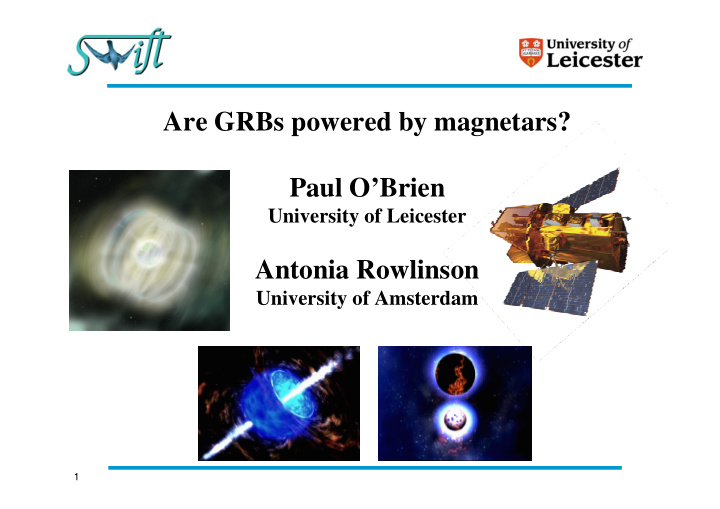



Are GRBs powered by magnetars? Paul O’Brien University of Leicester Antonia Rowlinson University of Amsterdam 1
GRB magnetar models Magnetars produced by: Collapsar, AIC of WD, NS-NS merger, WD-WD merger GRBs may be powered by magnetars (e.g., Usov 1992; Duncan & Thompson 1992; Dai et al. 2006; Metzger 2009; Ozel et al. 2010; Metzger et al. 2011) 2) Extraction of rotationalenergy � inject energy into the light curve (plateau phase) � rapid decline if magnetar collapses to BH (Zhang & Mészáros 2001) Binary Merger – SGRBs Collapsar – LGRBs 2
GRB 070110: a magnetar l.c.? (Troja et al. 2007) See a late plateau followed by a very steep decay in X-rays. Not seen in the optical (common among many candidates) In Lyons et al. (2010) we found 10 magnetar candidates LGRBs up to 2008 3
GRB 090515 – a short magnetar? (Rowlinson, O’Brien et al. 2010) T 90 = 0.036s GRB 090515 (blue) Fluence = 2x10 -8 erg s -1 (15-150 keV) GRB 050509B (green) Brightest short GRB in X-rays at 100s GRB 050813 (red) Very unusual given low γ -ray fluence Very faint optical transient seen (r=26.4 at ~2hr) Magnetar model fit assuming z~0.7 4
GRB 090515 and the long GRBs Blue and purple lines: 090515 at various z for a neutron star of 1.4 or 2.1 M � . Red upper lines: impose causality limit Green points: LGRBs (Lyons et al. 2010) Breakup limit 2 / P 0 2 / B p 4 and T em ∝ 2 L ∝ ∝ B p ∝ P 0 ∝ ∝ ∝ ∝ Expected relation between the pulsar initial spin period (P 0 ), dipole field strength (B p ), luminosity (L) and the characteristic timescale (T em ) for spin-down 5
Swift SGRB sample (Rowlinson et al., 2012) • 43 SGRBs up to March 2012, 37 of which were detected with the XRT • Do not include those SGRBs with extended tails (T90 ≤ 2s) • Significant fraction of SGRBs are not well fitted by a single PL decay in the XRT data (see also Margutti et al. 2012) • 28/37 have sufficient data to try a magnetar model fit to BAT+XRT Collapse to BH Magnetar survives 6
Derived magnetar parameters Green: unstable magnetar Blue: stable magnetar Typical B ~ few 10 16 G, period ~few msec We assume mean redshift (z=0.72) for those without a redshift determination. We also assume isotropic emission. Redshift and beaming uncertainty causes scatter. 7
Hot off the press… Best fit (assuming z=0.72) P = 5.7ms B = 1.7 x 10 16 G 8
Test model using gravity waves? Phase Amplitude A-LIGO limit ET limit (h) (Mpc) (Mpc) 4 x 10 -24 NS-NS Inspiral 445 5900 (Abadie et al 2010) <1.7 x 10 -23 Magnetar spin <85 <570 down (Corsi & Mezsaros 2009) Long GRBs Short GRBs 4 x 10 -23 Collapse to BH 100 1300 (Novak 1998) 9
Summary • SGRBs show many features in their X-ray light curves similar to those seen in LGRBs, but SGRBs do it earlier. • For the SGRBs with good X-ray data available, at least 75% can be fitted by a magnetar model. • Around a third or more of these magnetars eventually collapse to a BH while the rest may survive. • Could see 2 or 3 GW signals for these models? Rate very low for A-LIGO but good for ET. To test any progenitor model we need a functioning GRB trigger satellite in the era of A-LIGO, IceCube, CTA, LOFAR, E-ELT, ET, SKA etc., etc. (e.g. SVOM, Lobster, Janus, UFFO. A-STAR…) 10
Recommend
More recommend